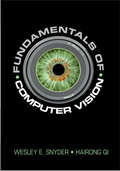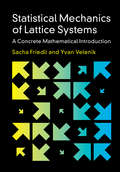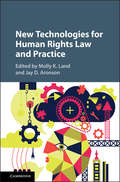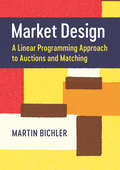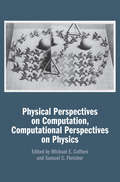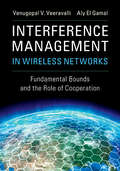- Table View
- List View
The Measure of All Minds
by José Hernández-OralloAre psychometric tests valid for a new reality of artificial intelligence systems, technology-enhanced humans, and hybrids yet to come? Are the Turing Test, the ubiquitous CAPTCHAs, and the various animal cognition tests the best alternatives? In this fascinating and provocative book, José Hernández-Orallo formulates major scientific questions, integrates the most significant research developments, and offers a vision of the universal evaluation of cognition. By replacing the dominant anthropocentric stance with a universal perspective where living organisms are considered as a special case, long-standing questions in the evaluation of behavior can be addressed in a wider landscape. Can we derive task difficulty intrinsically? Is a universal g factor - a common general component for all abilities - theoretically possible? Using algorithmic information theory as a foundation, the book elaborates on the evaluation of perceptual, developmental, social, verbal and collective features and critically analyzes what the future of intelligence might look like. Provides a universal framework integrating the evaluation of development, social and communication skills, and collective intelligence Compares the behavior evaluation of humans, non-human animals, and computers Blends cutting-edge theory and technology with historical context
Fundamentals of Computer Vision
by Wesley E. Snyder Hairong QiComputer vision has widespread and growing application including robotics, autonomous vehicles, medical imaging and diagnosis, surveillance, video analysis, and even tracking for sports analysis. This book equips the reader with crucial mathematical and algorithmic tools to develop a thorough understanding of the underlying components of any complete computer vision system and to design such systems. These components include identifying local features such as corners or edges in the presence of noise, edge preserving smoothing, connected component labeling, stereopsis, thresholding, clustering, segmentation, and describing and matching both shapes and scenes. The extensive examples include photographs of faces, cartoons, animal footprints, and angiograms, and each chapter concludes with homework exercises and suggested projects. Intended for advanced undergraduate and beginning graduate students, the text will also be of use to practitioners and researchers in a range of applications.
Statistical Mechanics of Lattice Systems: A Concrete Mathematical Introduction
by Sacha Friedli Yvan VelenikThis motivating textbook gives a friendly, rigorous introduction to fundamental concepts in equilibrium statistical mechanics, covering a selection of specific models, including the Curie–Weiss and Ising models, the Gaussian free field, O(n) models, and models with Kać interactions. Using classical concepts such as Gibbs measures, pressure, free energy, and entropy, the book exposes the main features of the classical description of large systems in equilibrium, in particular the central problem of phase transitions. It treats such important topics as the Peierls argument, the Dobrushin uniqueness, Mermin–Wagner and Lee–Yang theorems, and develops from scratch such workhorses as correlation inequalities, the cluster expansion, Pirogov–Sinai Theory, and reflection positivity. Written as a self-contained course for advanced undergraduate or beginning graduate students, the detailed explanations, large collection of exercises (with solutions), and appendix of mathematical results and concepts also make it a handy reference for researchers in related areas. Builds a narrative around the driving concepts, focusing on specific examples and models. Self-contained and accessible. Features numerous exercises and solutions, as well as a comprehensive appendix.
Algorithmic Aspects of Machine Learning
by Ankur MoitraThis book bridges theoretical computer science and machine learning by exploring what the two sides can teach each other. It emphasizes the need for flexible, tractable models that better capture not what makes machine learning hard, but what makes it easy. Theoretical computer scientists will be introduced to important models in machine learning and to the main questions within the field. Machine learning researchers will be introduced to cutting-edge research in an accessible format, and gain familiarity with a modern, algorithmic toolkit, including the method of moments, tensor decompositions and convex programming relaxations. The treatment beyond worst-case analysis is to build a rigorous understanding about the approaches used in practice and to facilitate the discovery of exciting, new ways to solve important long-standing problems.
Advances in Disordered Systems, Random Processes and Some Applications
by Pierluigi Contucci Cristian GiardinàThis book offers a unified perspective on the study of complex systems for scholars of various disciplines, including mathematics, physics, computer science, biology, economics and social science. The contributions, written by leading scientists, cover a broad set of topics, including new approaches to data science, the connection between scaling limits and conformal field theories, and new ideas on the Legendre duality approach in statistical mechanics of disordered systems. The volume moreover explores results on extreme values of correlated random variables and their connection with the Riemann zeta functions, the relation between diffusion phenomena and complex systems, and the Brownian web, which appears as the universal scaling limit of several probabilistic models. Written for researchers from a broad range of scientific fields, this text examines a selection of recent developments in complex systems from a rigorous perspective. Includes accounts of recent probabilistic methods used to investigate scaling limits from discrete to continuum models. Maths and physics are presented side by side in order to solve current open problems in disordered systems. Readers will be exposed to an up-to-date treatment of large databases, as well as to their theoretical modelisation.
Programming in Haskell
by Graham HuttonHaskell is a purely functional language that allows programmers to rapidly develop clear, concise, and correct software. The language has grown in popularity in recent years, both in teaching and in industry. This book is based on the author's experience of teaching Haskell for more than twenty years. All concepts are explained from first principles and no programming experience is required, making this book accessible to a broad spectrum of readers. While Part I focuses on basic concepts, Part II introduces the reader to more advanced topics. This new edition has been extensively updated and expanded to include recent and more advanced features of Haskell, new examples and exercises, selected solutions, and freely downloadable lecture slides and example code. The presentation is clean and simple, while also being fully compliant with the latest version of the language, including recent changes concerning applicative, monadic, foldable, and traversable types.
Programming in Haskell
by Graham HuttonHaskell is a purely functional language that allows programmers to rapidly develop clear, concise, and correct software. The language has grown in popularity in recent years, both in teaching and in industry. This book is based on the author's experience of teaching Haskell for more than twenty years. All concepts are explained from first principles and no programming experience is required, making this book accessible to a broad spectrum of readers. While Part I focuses on basic concepts, Part II introduces the reader to more advanced topics. This new edition has been extensively updated and expanded to include recent and more advanced features of Haskell, new examples and exercises, selected solutions, and freely downloadable lecture slides and example code. The presentation is clean and simple, while also being fully compliant with the latest version of the language, including recent changes concerning applicative, monadic, foldable, and traversable types. This new edition has been extensively revised and expanded, including four new chapters as well as many new examples and exercises. Fully compliant with the latest version of Haskell, and updated to include more recent features. An accompanying website provides a range of supporting materials, including PowerPoint slides and Haskell code for the extended examples. <P><P><i>Advisory: Bookshare has learned that this book offers only partial accessibility. We have kept it in the collection because it is useful for some of our members. To explore further access options with us, please contact us through the Book Quality link on the right sidebar. Benetech is actively working on projects to improve accessibility issues such as these.</i>
Cloud Radio Access Networks
by Tony Q. S. Quek Mugen Peng Osvaldo Simeone Wei YuThis unique text will enable readers to understand the fundamental theory, current techniques, and potential applications of Cloud Radio Access Networks (C-RANs). Leading experts from academia and industry provide a guide to all of the key elements of C-RANs, including system architecture, performance analysis, technologies in both physical and medium access control layers, self-organizing and green networking, standards development, and standardization perspectives. Recent developments in the field are covered, as well as open research challenges and possible future directions. The first book to focus exclusively on Cloud Radio Access Networks, this is essential reading for engineers in academia and industry working on future wireless networks.
Wireless-Powered Communication Networks: Architectures, Protocols, and Applications
by Dusit Niyato Ekram Hossain Dong In Kim Vijay Bhargava Lotfollah ShafaiLearn the fundamentals of architecture design, protocol optimization, and application development for wireless-powered communication networks with this authoritative guide. Readers will gain a detailed understanding of the issues surrounding architecture and protocol design, with key topics covered including relay-based energy harvesting systems, multiple-antenna systems for simultaneous wireless information and power transfer (SWIPT), performance modeling and analysis, and ambient wireless energy harvesting based cellular systems. Current applications of energy harvesting and transfer in different wireless networking scenarios are discussed, aiding the understanding of practical system development and implementation issues from an engineering perspective. The first book to provide a unified view of energy harvesting and wireless power transfer networks from a communications perspective, this is an essential text for researchers working on wireless communication networks and wireless systems, RF engineers, and wireless application developers.
New Technologies for Human Rights Law and Practice
by Jay D. Aronson Molly K. LandNew technological innovations offer significant opportunities to promote and protect human rights. At the same time, they also pose undeniable risks. In some areas, they may even be changing what we mean by human rights. The fact that new technologies are often privately controlled raises further questions about accountability and transparency and the role of human rights in regulating these actors. This volume – edited by Molly K. Land and Jay D. Aronson – provides an essential roadmap for understanding the relationship between technology and human rights law and practice. It offers cutting-edge analysis and practical strategies in contexts as diverse as autonomous lethal weapons, climate change technology, the Internet and social media, and water meters. This title is also available as Open Access.
The Politics of Technology in Africa
by Iginio GagliardoneAs more Africans get online, information and communication technologies (ICTs) are increasingly hailed for their transformative potential. Yet, the fascination for the possibilities of promoting more inclusive forms of development in the information age have obfuscated the reality of the complex negotiations among political and economic actors who are seeking to use technology in their competition for power. Building on over ten years of research in Ethiopia, Iginio Gagliardone investigates the relationship between politics, development, and technological adoption in Africa's second most populous country and its largest recipient of development aid. The emphasis the book places on the 'technopolitics' of ICTs, and on their ability to embody and enact political goals, offers a strong and empirically grounded counter-argument to prevalent approaches to the study of technology and development that can be applied to other cases in Africa and beyond.
Strategic A2/AD in Cyberspace
by Russell Alison LawlorStrategic A2/AD in Cyberspace focuses on exclusion from cyberspace, or the ability of a state to be cut off entirely from cyberspace. Strategic anti-access and area denial (A2/AD) operations are common in other domains, but, before now, they have not been examined for their relevance to cyberspace. This book examines how strategic A2/AD operations can cut off states from cyberspace through attacks at either the physical or logic layers of cyberspace. The result of strategic cyber A2/AD operations could be catastrophic for modern economies, governments, military forces, and societies, yet there has been surprisingly little study of these threats to states' access to cyberspace. This book examines the implications of strategic cyber A2/AD operations for deterrence strategy and proposes a new view of how exclusion from cyberspace can be used as a coercive tool in diplomacy.
LDPC Code Designs, Constructions, and Unification
by Juane Li Shu Lin Khaled Abdel-Ghaffar William E. Ryan Daniel J. CostelloWritten by leading experts, this self-contained text provides systematic coverage of LDPC codes and their construction techniques, unifying both algebraic- and graph-based approaches into a single theoretical framework (the superposition construction). An algebraic method for constructing protograph LDPC codes is described, and entirely new codes and techniques are presented. These include a new class of LDPC codes with doubly quasi-cyclic structure, as well as algebraic methods for constructing spatially and globally coupled LDPC codes. Authoritative, yet written using accessible language, this text is essential reading for electrical engineers, computer scientists and mathematicians working in communications and information theory.
Market Design
by Martin BichlerThe digital economy led to many new services where supply is matched with demand for various types of goods and services. More and more people and organizations are now in a position to design market rules that are being implemented in software. The design of markets is challenging as it needs to consider strategic behavior of market participants, psychological factors, and computational problems in order to implement the objectives of a designer. Market models in economics have not lost their importance, but the recent years have led to many new insights and principles for the design of markets, which are beyond traditional economic theory. This book introduces the fundamentals of market design, an engineering field concerned with the design of real-world markets.
Compact Data Structures
by Gonzalo NavarroCompact data structures help represent data in reduced space while allowing it to be queried, navigated, and operated in compressed form. They are essential tools for efficiently handling massive amounts of data by exploiting the memory hierarchy. They also reduce the resources needed in distributed deployments and make better use of the limited memory in low-end devices. The field has developed rapidly, reaching a level of maturity that allows practitioners and researchers in application areas to benefit from the use of compact data structures. This first comprehensive book on the topic focuses on the structures that are most relevant for practical use. Readers will learn how the structures work, how to choose the right ones for their application scenario, and how to implement them. Researchers and students in the area will find in the book a definitive guide to the state of the art in compact data structures.
Construction Robots: Elementary Technologies and Single-Task Construction Robots ( Cambridge handbooks in construction robotics vol. #3)
by Thomas Bock Thomas LinnerLearn how Single-Task Construction Robots (STCRs) can improve productivity in the construction industry with this cross-disciplinary text. This third volume in the Cambridge Handbooks in Construction Robotics series discusses the STCRs employed on construction sites since the development of the approach in the 1980s, presents current applications, and highlights upcoming trends in the construction automation and robotics field. Two hundred different types of STCR are presented, from the simplest models comprising simple manipulators and mobile platforms, to those utilizing more sophisticated technologies such as aerial robotics, swarm robotics, exoskeletons, additive manufacturing technologies, self-assembling building structures, and humanoid robotics. Real-world case studies demonstrate the different application scenarios for each approach, and highlight the key implementation and management issues. With an easy-to-follow structure, and including hundreds of color illustrations, it provides an excellent toolkit for professional engineers, researchers, and students. Provides a new interpretation of architecture and construction as a manufacturing industry that deals with product rather than with buildings - from building 'construction' to building 'production' Follows a cross-disciplinary approach that relates traditional architectural and construction knowledge the with latest knowledge from manufacturing, automation and robot technology Oriented towards technology application, using real-world case studies to show application scenarios for each presented approach or technology
Introduction to Software Testing
by Jeff Offutt Paul AmmannExtensively class-tested, this textbook takes an innovative approach to software testing: it defines testing as the process of applying a few well-defined, general-purpose test criteria to a structure or model of the software. It incorporates the latest innovations in testing, including techniques to test modern types of software such as OO, web applications, and embedded software. The book contains numerous examples throughout. An instructors solution manual, PowerPoint slides, sample syllabi, additional examples and updates, testing tools for students, and example software programs in Java are available on an extensive website.
Physical Perspectives on Computation, Computational Perspectives on Physics
by Michael E. Cuffaro Samuel C. FletcherAlthough computation and the science of physical systems would appear to be unrelated, there are a number of ways in which computational and physical concepts can be brought together in ways that illuminate both. <P><P>This volume examines fundamental questions which connect scholars from both disciplines: is the universe a computer? Can a universal computing machine simulate every physical process? What is the source of the computational power of quantum computers? Are computational approaches to solving physical problems and paradoxes always fruitful? Contributors from multiple perspectives reflecting the diversity of thought regarding these interconnections address many of the most important developments and debates within this exciting area of research. Both a reference to the state of the art and a valuable and accessible entry to interdisciplinary work, the volume will interest researchers and students working in physics, computer science, and philosophy of science and mathematics.<P> Fills the gap in the book-length treatments of the interrelations between computation and physics, especially within philosophy.<P> Provides a reference point for the state of the art in important topics and research questions in this area.<P> Brings together scholars from a wide range of perspectives and disciplines.
Interference Management in Wireless Networks: Fundamental Bounds and the Role of Cooperation
by Venugopal V. Veeravalli Aly El GamalLearn about an information-theoretic approach to managing interference in future-generation wireless networks. Focusing on cooperative schemes motivated by coordinated multi-point (CoMP) technology, the book develops a robust theoretical framework for interference management that uses recent advancements in backhaul design, and practical pre-coding schemes based on local cooperation, to deliver the increased speed and reliability promised by interference alignment. Gain insight into how simple, zero-forcing pre-coding schemes are optimal in locally connected interference networks, and discover how significant rate gains can be obtained by making cell association decisions and allocating backhaul resources based on centralized (cloud) processing and knowledge of network topology. Providing a link between information-theoretic analyses and interference management schemes that are easy to implement, this is an invaluable resource for researchers, graduate students, and practicing engineers in wireless communications.
Temporal Logics in Computer Science
by Stéphane Demri Valentin Goranko Martin LangeThis comprehensive text provides a modern and technically precise exposition of the fundamental theory and applications of temporal logics in computer science. Part I presents the basics of discrete transition systems, including constructions and behavioural equivalences. Part II examines the most important temporal logics for transition systems and Part III looks at their expressiveness and complexity. Finally, Part IV describes the main computational methods and decision procedures for model checking and model building - based on tableaux, automata and games - and discusses their relationships. The book contains a wealth of examples and exercises, as well as an extensive annotated bibliography. Thus, the book is not only a solid professional reference for researchers in the field but also a comprehensive graduate textbook that can be used for self-study as well as for teaching courses.
A First Course in Statistical Programming with R
by W. John Braun Duncan J. MurdochThis is the only introduction you'll need to start programming in R, the open-source language that is free to download, and lets you adapt the source code for your own requirements. Co-written by one of the R Core Development Team, and by an established R author, this book comes with real R code that complies with the standards of the language. Unlike other introductory books on the ground-breaking R system, this book emphasizes programming, including the principles that apply to most computing languages, and techniques used to develop more complex projects. Learning the language is made easier by the frequent exercises and end-of-chapter reviews that help you progress confidently through the book. Solutions, datasets and any errata will be available from the book's web site. The many examples, all from real applications, make it particularly useful for anyone working in practical data analysis.
Algorithms and Models for Network Data and Link Analysis
by François Fouss Marco Saerens Masashi ShimboNetwork data are produced automatically by everyday interactions - social networks, power grids, and links between data sets are a few examples. Such data capture social and economic behavior in a form that can be analyzed using powerful computational tools. This book is a guide to both basic and advanced techniques and algorithms for extracting useful information from network data. The content is organized around 'tasks', grouping the algorithms needed to gather specific types of information and thus answer specific types of questions. Examples include similarity between nodes in a network, prestige or centrality of individual nodes, and dense regions or communities in a network. Algorithms are derived in detail and summarized in pseudo-code. The book is intended primarily for computer scientists, engineers, statisticians and physicists, but it is also accessible to network scientists based in the social sciences. Matlab/Octave code illustrating some of the algorithms will be available at: http://www. cambridge. org/9781107125773.
Big Crisis Data
by Carlos CastilloSocial media is an invaluable source of time-critical information during a crisis. However, emergency response and humanitarian relief organizations that would like to use this information struggle with an avalanche of social media messages that exceeds human capacity to process. Emergency managers, decision makers, and affected communities can make sense of social media through a combination of machine computation and human compassion - expressed by thousands of digital volunteers who publish, process, and summarize potentially life-saving information. This book brings together computational methods from many disciplines: natural language processing, semantic technologies, data mining, machine learning, network analysis, human-computer interaction, and information visualization, focusing on methods that are commonly used for processing social media messages under time-critical constraints, and offering more than 500 references to in-depth information.
The Inner Workings of Life
by Eberhard O. VoitLiving systems are dynamic and extremely complex and their behaviour is often hard to predict by studying their individual parts. Systems biology promises to reveal and analyse these highly connected, regulated and adaptable systems, using mathematical modelling and computational analysis. This new systems approach is already having a broad impact on biological research and has potentially far-reaching implications for our understanding of life. Written in an informal and non-technical style, this book provides an accessible introduction to systems biology. Self-contained vignettes each convey a key theme and are intended to enlighten, provoke and interest readers of different academic disciplines, but also to offer new insight to those working in the field. Using a minimum amount of jargon and no mathematics, Voit manages to convey complex ideas and give the reader a genuine sense of the excitement that systems biology brings with it, as well as the current challenges and opportunities.
Educational Psychology and the Internet
by Michael GlassmanThe first comprehensive, research-based textbook on Internet-infused education, Educational Psychology and the Internet offers students an accessible guide to important issues in the field. Michael Glassman begins with an overview of the history that traces the evolution of the Internet and its significance for education. He outlines the current state of research, clearly defining terms that students will need to discuss larger concepts, such as hypertext and cyberspace. The second part of the book explores the practical applications of this research, which range from the individual-oriented to the generalized, including massive open online courses (MOOCs), open educational resources, and augmented reality. Key issues that affect teachers and students today, such as Net Neutrality and Creative Commons and Open Source licenses, are explained in straightforward terms, and often-overlooked differences - for example, between course management systems and learning management systems, and between blogs, social networking sites, and short messaging systems - are highlighted.

